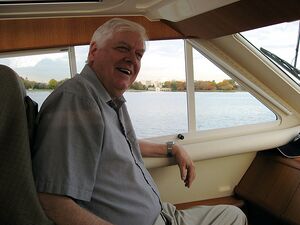هاملتون سميث
هاملتون ا. سميث Hamilton O. Smith | |
|---|---|
 هاملتون ا. سميث | |
| وُلِدَ | 23 اغسطس, 1931 |
| الجنسية | الولايات المتحدة |
| المدرسة الأم | جامعة كاليفورنيا، بركلي، BA كلية جونز هوپكنز للطب، MD |
| اللقب | إنزيمات الاقتطاع |
| الجوائز | جائزة نوبل في الفسيولوجيا أو الطب في 1978 |
| السيرة العلمية | |
| المجالات | علم الأحياء الجزيئي, biochemistry, genomics |
| الهيئات | Washington University School of Medicine |
هاملتون أوثانل سميث (بالإنجليزية: Hamilton Othanel Smith) (و. (23 أغسطس 1931)، هو طبيب أمريكي حصل على جائزة نوبل في الطب عام 1978. مع السويسري ڤرنر أربر والأمريكي دانيال ناثانز لاكتشافهم إنزيم الاقتطاع.
. . . . . . . . . . . . . . . . . . . . . . . . . . . . . . . . . . . . . . . . . . . . . . . . . . . . . . . . . . . . . . . . . . . . . . . . . . . . . . . . . . . . . . . . . . . . . . . . . . . . . . . . . . . . . . . . . . . . . . . . . . . . . . . . . . . . . . . . . . . . . . . . . . . . . . . . . . . . . . . . . . . . . . . .
السيرة
ولد سميث في 23 أغسطس 1931، وتخرج في مدرسة المختبر الجامعي العليا في إربانا، إلينوي، ثم التحق بجامعة إلينوي، إربانا-شامپين، ولكنه انتقل عام 1950 إلى جامعة كاليفورنيا في بركلي، حيث حصل على درجة البكالوريوس في الرياضيات سنة 1952. وفي سنة 1956 حصل سميث على شهادة الطب من جامعة جونز هوپكنز. وفي سنة 1975 فاز بزمالة گوگنهايم وقضى فترتها في جامعة زيورخ.
في سنة 1970 اكتشف سميث وكنت ولكوكس أول إنزيم ينتمي إلى النوع الثاني من إنزيمات الاقتطاع (وهو الإنزيم الذي يسمى حاليًا HindII)، ثم اكتشف سميث إنزيم دنا ميثيلاز.
He was awarded the Nobel Prize in Physiology or Medicine in 1978 for discovering type II restriction enzymes with Werner Arber and Daniel Nathans as co-recipients.
He later became a leading figure in the nascent field of genomics, when in 1995 he and a team at The Institute for Genomic Research sequenced the first bacterial genome, that of Haemophilus influenzae.[1] H. influenza was the same organism in which Smith had discovered restriction enzymes in the late 1960s. He subsequently played a key role in the sequencing of many of the early genomes at The Institute for Genomic Research, and in the assembly of the human genome at Celera Genomics, which he joined when it was founded in 1998.
More recently, he has directed a team at the J. Craig Venter Institute that works towards creating a partially synthetic bacterium, Mycoplasma laboratorium. In 2003 the same group synthetically assembled the genome of a virus, Phi X 174 bacteriophage. Smith is scientific director of privately held Synthetic Genomics, which was founded in 2005 by Craig Venter to continue this work. Synthetic Genomics is working to produce biofuels on an industrial-scale using recombinant algae and other microorganisms.[2]
المصادر
- ^ Smith, H. O.; Wilcox, K. W. (1992). "A restriction enzyme from Hemophilus influenzae. I. Purification and general properties. 1970". Biotechnology (Reading, Mass.). 24: 38–50. PMID 1330118.
- ^ "Craig Venter Has Algae Biofuel in Synthetic Genomics' Pipeline - Xconomy". Xconomy. 4 June 2009.
وصلات خارجية
- Short description is different from Wikidata
- Pages using infobox scientist with unknown parameters
- علماء ميكروبات أمريكان
- أعضاء أكاديمية العلوم الوطنية الأمريكية
- علماء أحياء أمريكان
- Phage workers
- حائزو جائزة نوبل في الطب
- حائزو جائزة نوبل أمريكان
- خريجو جامعة كاليفورنيا، بركلي
- خريجو جامعة جونز هوپكنز
- مواليد 1931
- University Laboratory High School (Urbana, Illinois) alumni
- Biotechnologists
- Human Genome Project scientists
- Washington University School of Medicine faculty
